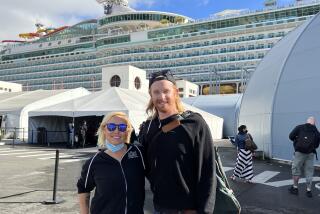MISSION VIEJO : Cruise Will Be Therapy for Patients
- Share via
For people with respiratory problems, decreased lung capacity does not only restrict breathing. It can also restrict activities, ranging from taking a walk to taking a vacation.
But now that six graduates of the pulmonary rehabilitation program at Mission Hospital Regional Medical Center have relearned how to breathe and have tackled formerly impossible activities like taking a walk, the hospital plans to further test their new-found endurance on a seven-day cruise to Mexico in March.
For four weeks, the rehabilitation program’s participants, who suffer from respiratory conditions such as bronchitis, asthma and emphysema, learned to improve their stamina and control their episodes of shortness of breath. But now, doctors and therapists say, they are faced with controlling the psychological fears that dominated their lives.
“Patients with severe emphysema live breath to breath,” said George Schiffman, a physician who specializes in pulmonary diseases. “When they get short of breath, it provokes anxiety. They live in fear from each episode to the next. These people tend to become hermits because they don’t want people to . . . see them get short of breath. But when they get together as a group, they see others have similar problems.”
Jim Barnett, a respiratory therapist and the program’s coordinator, said the need for group support led to the idea of a cruise for the patients, who need the security of having along medical personnel who understand their medical conditions and can handle their oxygen equipment.
“Some of the people wouldn’t feel comfortable to take a vacation on their own,” he said. While on the cruise, program graduates will continue exercises which assist them in breathing-control techniques.
“The exercises taught me how to be more relaxed when I’m having trouble breathing and to get the best use out of my remaining lung capacity,” said program graduate Melodee Botts, 44, of El Toro. “Basically, the program taught me to use my head before I use my air.”
Botts said she has had asthma and other pulmonary problems most of her life and functions with the capacity of one lung.
Schiffman, the program’s medical director, said the classes during the four-week program teach people with respiratory problems to understand their medications and the nature of their illnesses. A respiratory therapist, nurse, pharmacist, dietitian, social worker, occupational therapist and exercise physiologist work together to return the participants to a more productive life.
The therapy helps participants break the cycle of inactivity, Schiffman said.
“For example, these people may get short of breath walking to the corner store for a newspaper,” he said. “So rather than having the feeling of suffocating, they give up walking to the store. Then they get short of breath just answering the doorbell, and then finally just combing their hair. They get out of condition, which causes an increase in shortness of breath with less activity. So what we do is break that cycle by giving them more activity in a graded fashion.”
Hazel Mickelson, 74, of Mission Viejo, a smoker for 50 years, said she stopped activity on a treadmill one minute after she first tried it in class.
“Now I can stay on for 30 minutes,” Mickelson said. “I walk now. Before the classes, I used to be afraid. When I couldn’t breathe, I’d panic.”
Jeanne Bauer, 46, also of Mission Viejo, said she was used to exercising before attending the classes, but now requires the use of oxygen 12 hours a day because of a diminished breathing capacity caused by scoliosis, a curvature of the spine.
“I’ve learned how to save energy for fun things,” she said. “I can put on a portable oxygen pack and go.”
Bauer said the group has given her emotional support. “I used to feel alone with this problem,” she said. “I now have someone I can call who understands.”
More to Read
Sign up for Essential California
The most important California stories and recommendations in your inbox every morning.
You may occasionally receive promotional content from the Los Angeles Times.













